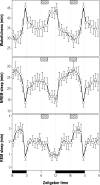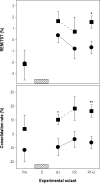REM sleep phase preference in the crepuscular Octodon degus assessed by selective REM sleep deprivation
- PMID: 23904685
- PMCID: PMC3700722
- DOI: 10.5665/sleep.2896
REM sleep phase preference in the crepuscular Octodon degus assessed by selective REM sleep deprivation
Abstract
Study objectives: To determine rapid eye movement (REM) sleep phase preference in a crepuscular mammal (Octodon degus) by challenging the specific REM sleep homeostatic response during the diurnal and nocturnal anticrepuscular rest phases.
Design: We have investigated REM sleep rebound, recovery, and documented REM sleep propensity measures during and after diurnal and nocturnal selective REM sleep deprivations.
Subjects: Nine male wild-captured O. degus prepared for polysomnographic recordings.
Interventions: Animals were recorded during four consecutive baseline and two separate diurnal or nocturnal deprivation days, under a 12:12 light-dark schedule. Three-h selective REM sleep deprivations were performed, starting at midday (zeitgeber time 6) or midnight (zeitgeber time 18).
Measurements and results: Diurnal and nocturnal REM sleep deprivations provoked equivalent amounts of REM sleep debt, but a consistent REM sleep rebound was found only after nocturnal deprivation. The nocturnal rebound was characterized by a complete recovery of REM sleep associated with an augment in REM/total sleep time ratio and enhancement in REM sleep episode consolidation.
Conclusions: Our results support the notion that the circadian system actively promotes REM sleep. We propose that the sleep-wake cycle of O. degus is modulated by a chorus of circadian oscillators with a bimodal crepuscular modulation of arousal and a unimodal promotion of nocturnal REM sleep
Keywords: Octodon degus; REM sleep; REM sleep homeostasis; REM sleep rebound; crepuscular chronotype.
Figures






References
-
- Labyak SE, Lee TM, Goel N. Rhythm chronotypes in a diurnal rodent, Octodon degus. Am J Physiol. 1997;273:R1058–66. - PubMed
-
- Cuesta M, Clesse D, Pévet P, Challet E. From daily behavior to hormonal and neurotransmitters rhythms: comparison between diurnal and nocturnal rat species. Horm Behav. 2009;55:338–47. - PubMed
-
- McElhinny TL, Smale L, Holekamp KE. Patterns of body temperature, activity, and reproductive behavior in a tropical murid rodent, Arvicanthis niloticus. Physiol Behav. 1997;62:91–6. - PubMed
-
- Katona C, Smale L. Wheel-running rhythms in Arvicanthis niloticus. Physiol Behav. 1997;61:365–72. - PubMed
Publication types
MeSH terms
LinkOut - more resources
Full Text Sources
Other Literature Sources

